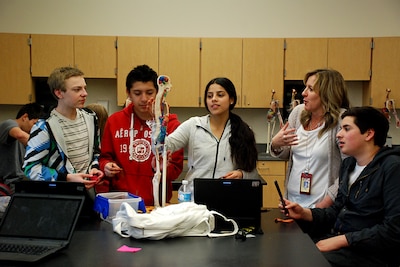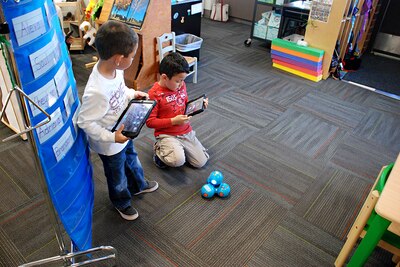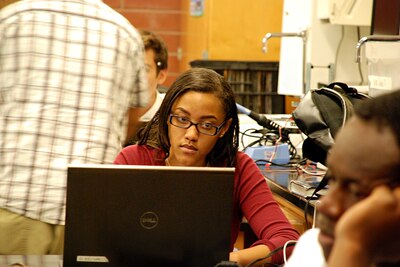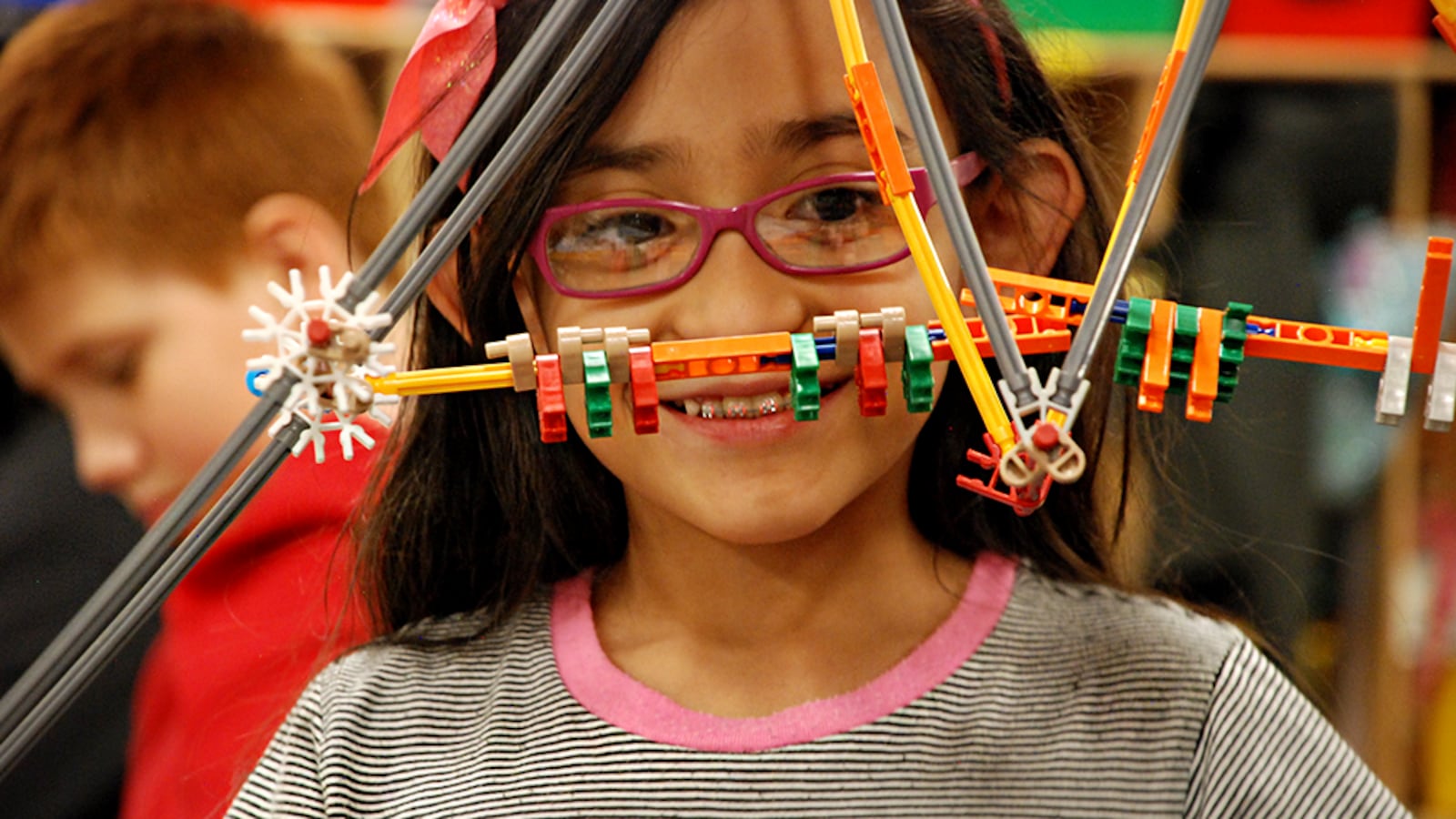In Longmont, preschoolers learn the basics of coding by giving directions to a robot named Dash that moves across the floor.
In Pueblo, fifth graders study the way germs move around the room and must decide whether soap and water or hand sanitizer does a better job of stopping them.
In Northglenn, high school seniors spend months studying genetically modified foods and then pitch industry experts ideas on how to curb hunger in developing countries.
These are just some of the many examples of the work thousands of Colorado students are doing in classrooms across the state that have put a new emphasis on a blend of coursework in science, technology, math and engineering, known as STEM.
A buzzword in public education and a popular concept with the business community, STEM is billed as an integrated, interdisciplinary approach to learning that exposes students to hands-on experiences to prepare them for the 21st century economy.
To get a measure of STEM education in Colorado, Chalkbeat surveyed the state’s 30 largest districts, which enroll more than 80 percent of the state’s students, about their courses and programs. All but two districts — Greeley and Montrose County — provided information.
A Chalkbeat analysis, the first of its kind in the state, found that two out of every seven students in the responding districts have access to a STEM education. Advocates say that isn’t enough to meet demand. In nearly six in 10 schools with STEM programming, the number of students of color enrolled equals or exceeds the number of minority students in their respective districts — a promising sign that STEM efforts are reaching underprivileged students.
STEM in Colorado | A Chalkbeat special report
PART 1: Little access to STEM education
PART 2: St. Vrain goes all in on STEM
PART 3: What the heck is STEM?
PART 4: A scrappy STEM school with something to prove
FIRST PERSON: How my STEM education is going to help me get clean drinking water in Ethiopia
HOW I TEACH STEM: An award-winning science teacher shares her classroom practices.
HOW I TEACH STEM: An award winning fourth-grade teacher shares her classroom practices.
The Gay & Lesbian Fund for Colorado provided financial support for this series.
Dozens of interviews with school officials, teachers and STEM advocates found vastly different approaches to STEM, little data about its impact on student learning, few state standards defining STEM education and disagreement about whether adopting more would either help or harm efforts to provide quality STEM education.
“The point is, we want to train our children to participate in our economy,” said Angela Baber, director of STEM at the Colorado Education Initiative, an education advocacy nonprofit. “But I think we’re hard-pressed to say we’re meeting the demand.”
Colorado’s economy is becoming increasingly digital. About 23 percent of all jobs in Colorado are in STEM fields such as engineering, renewable energy or computer coding, according to the Colorado Workforce Development Council. Between 2000 and 2010, the number of STEM jobs grew by 7.9 percent, almost triple the rate of other jobs, according to CEI.
It’s a shame only two out of every seven kids in the districts surveyed have access to STEM education, said Stephanie Veck, executive director of the development council, which studies the state’s job market.
“In this day and age, we should be doing everything we can to make sure that every kid has access to project-based learning and applied learning so they understand the relevancy of their education,” she said. “We have to understand that STEM isn’t just for someone who wants to be an engineer. It’s for anyone who wants to get on a great path to a career.”
Baber and other STEM advocates say the state is far from understanding the quality of its current STEM offerings.
“STEM, it’s a bit of a hot thing,” she said. “Some schools and some programs will slap STEM on a program and it doesn’t necessarily deliver the outcome we hope for students.”
What is STEM?
Because there is no singular definition of STEM, courses take on a number of different forms.

There can be dedicated time to learning how to code computer programs, successive courses on biomedical science, or a semester-long project that incorporates work from a variety of core classes such as English and civics.
While Colorado has grade-specific academic standards for science and math, there is no state-level guidance for how the two subjects should be taught together in concert with engineering and technology.
That means each school and district can decide when and how STEM is taught.
Denver Public Schools, the state’s largest school district, building upon its career and technical education programs, has historically emphasized STEM at the high school level.
Some 2,000 DPS students last year were enrolled in STEM courses that blend classroom work with real-world job training. Students can choose from a variety of fields, including manufacturing and 3D animation.
This year DPS is adding more STEM labs to elementary schools and has hired a district-level administrator to beef up STEM experiences in younger grades.
The motto in the Cherry Creek School District is that “every school is a STEM school.” At the elementary level, students can learn the most basic concepts of space, programming, engineering and manufacturing. In middle school, students can also take on robotics. And high schools offer classes on automotive technology and advanced health science.
"If you’re going to put STEM on your school, you should be certified. "
Drew Hirshon, Pueblo Central High School’s STEM coordinator
The Fountain-Fort Carson School District 8, which educates a large number of students from military families, worked with the federal government to build an engineering program that runs from kindergarten through 12th grade.
Meanwhile, Pueblo City Schools has designated four schools — two elementary, a middle and a high school — as STEM schools. Like many other STEM schools across the state, an emphasis has been placed on applied learning and group projects. Instead of rote memorization, entire classes are dedicated to solving real-world problems.
Educators and activists are split on whether the state legislature should take steps to define STEM education in Colorado.
One camp believes the state should at least set some kind of criteria for schools to label themselves STEM. This already happens on a very small scale. High schools that receive federal or state funding for career and technical education must submit course guides to the Colorado Community College System for approval. But those courses represent only a fraction of what’s happening in classrooms.
“If you’re going to put STEM on your school, you should be certified,” said Drew Hirshon, Pueblo Central High School’s STEM coordinator.
"I think to legislate STEM, it could be dangerous."
Penny Eucker, executive director of the STEM School and Academy,
Hirshon speaks from experience. The Pueblo school’s STEM program was accredited by AdvancED, a nonprofit that conducts independent reviews of school programs.
Others worry that lawmakers could define STEM too narrowly, stifling innovation.
“I think to legislate STEM, it could be dangerous,” said Penny Eucker, executive director of the STEM School and Academy, a charter school in Douglas County.
State lawmakers did take a small step toward creating more uniform STEM standards this year when they asked the Colorado Department of Education to create computer science standards for the state’s schools. That work will begin next year when the state reviews all of its standards.
Little data
There is little evidence in state testing data of how STEM initiatives are paying off, experts say. And there’s little agreement on what the state should be measuring to understand whether the needle is moving.

A change in student assessments means results on the state’s science and math tests won’t be able to spotlight trends for at least another year. Meanwhile, student performance on national math and science tests including the ACT and the National Assessment of Educational Progress, or NAEP, have barely budged upward.
There has been an uptick in the number of black and Hispanic students taking advanced high school math and science classes for college credit. In 2010, nearly 14,000 Colorado students took an Advanced Placement course and corresponding test in math or science, according to state data. Of those, about 15 percent were either black or Hispanic. Five years later, the figure was 19 percent.
But the state does not release how well those students performed on the tests. Colleges usually require students to earn at least a score of three out of five points to earn credit.
And there’s no immediate way of knowing whether any positive changes are due to STEM courses, especially when there are other initiatives pushing more students to take AP classes and tests for college credit.
Richard Charles, Cherry Creek School District’s STEM director, and others believe the quality of a STEM program shouldn’t be measured by test scores but by how often a student produces something, be it a research paper, mobile app or rocket.
“You don’t have to have an AP course to experience STEM at a very high level and rich experience,” Charles said.
Equitable access
The federal government, industry leaders, foundations and nonprofits for several years have pushed, and in many cases financially incentivized, schools to make STEM courses a priority for female students, students of color and those who come from poor households.

That’s because the current STEM workforce is overwhelmingly white and male.
Students from diverse backgrounds “see things from a different perspective and they could bring in new ideas to the workforce,” said Chris James, an administrator for the Fountain-Fort Carson school district who helped put in place the district’s STEM efforts.
It’s impossible to say just how much has been invested in Colorado schools for this effort — hundreds of millions, most likely. The incentives appear to be having an impact.
Fifty-seven percent of all schools that offer STEM courses in Colorado serve the same percentage — or a higher percentage — of at-risk students as their respective districts, according to Chalkbeat’s survey.
“It’s incredibly promising, especially for students who may not have had those educational programs in the past,” said Christina Jean, the former director of innovation and choice at the Colorado Department of Education.
School districts such as St. Vrain Valley, Pueblo City Schools, Adams 12 Five Star and Fountain-Fort Carson have built STEM programs for schools that serve the district’s most at-risk students.
At Adams 12’s Northglenn High, where 70 percent of students are either black or Latino, the district converted the school’s old swimming pool building into a high-tech lab where hundreds of students throughout the day study the basics of engineering and biology. And the school has adopted a STEM culture across all subjects, putting a greater emphasis on projects.
And this year, Northglenn is one of two high schools in the state launching so-called P-TECH schools. The second school is Skyview in Longmont. Students who enroll in the P-TECH program can earn a high school diploma, associate’s degree and the possibility of a job with a local technology company.
Part of the P-TECH model involves recruiting female students and would-be first-generation college students. As part of its effort to get more female students interested in STEM, Northglenn has paired third- and fifth-grade girls with high school mentors.
“We want kids to always feel like they can achieve anything,” said Kerry Glenn, Northglenn’s STEM coordinator.
"A lot of girls think engineering is just going to be too difficult."
Coree Morgan, Rangeview High School student
Other schools, like Rangeview High in Aurora, have similar initiatives to enroll girls in STEM programs.
Last year, the school’s STEM department sent personal invitations to female eighth graders at nearby middle schools encouraging them to enroll.
Coree Morgan, a junior at Rangeview who has been in the district’s STEM program since middle school, said she can understand why there aren’t more girls in her class.
“A lot of girls think engineering is just going to be too difficult,” she said.
At Pueblo Central High School, female students are tasked with leaderships roles, especially with recruiting younger students. That work has paid off, said the school’s principal, Lynn Seifert. The student makeup of the STEM programs match the school’s demographics, she said.
“We don’t want to leave anyone out who wants to put forth the effort,” Seifert said. “It helps if you never tell them they can’t.”
Correction: An earlier version of this article misspelled Angela Baber’s last name. This post has also been updated to better describe Northglenn High’s STEM program.


